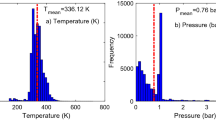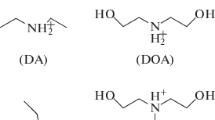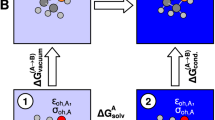Abstract
Prediction of liquid-liquid phase equilibria is an important goal in the physical chemistry of solutions. Quantum chemistry methods, combined with a dielectric continuum description of the solvent, has received attention as a first principle approach. In this work, the performance of the continuum solvation model based on density (SMD) for prediction of γ∞ in binary liquid mixtures, using 46 values of γ∞, was evaluated. We found the mean uncertainty of RTln γ∞ to be 0.92 kcal mol−1. Based on the calculated γ∞ and the two parameters of the Redlich-Kister expansion, we calculated the liquid-liquid phase equilibria. Based on 26 values of solubility, an uncertainty of 0.66 was found in the logarithm of molar fraction of the smallest component in each phase. Our results suggest this approach can be used for fast and semi-quantitative prediction of phase behavior. More reliable predictions could be obtained with improvements in the SMD model.

Prediction of liquid-liquid phase equilibriaᅟ




Similar content being viewed by others
References
Deglmann P, Schäfer A, Lennartz C (2015) Application of quantum calculations in the chemical industry—an overview. Int J Quantum Chem 115:107–136
Tomasi J, Mennucci B, Cammi R (2005) Quantum mechanical continuum solvation models. Chem Rev 105:2999–3093
Klamt A, Mennucci B, Tomasi J, Barone V, Curutchet C, Orozco M, Luque FJ (2009) On the performance of continuum solvation methods. A comment on “Universal approaches to solvation modeling”. Acc Chem Res 42:489–492
Cramer CJ, Truhlar DG (2008) A universal approach to solvation modeling. Acc Chem Res 41:760–768
Truhlar DG, Pliego JR, Jr (2007) Transition state theory and chemical reaction dynamics in solution. In: Mennucci B, Cammi R, editors. Continuum solvation models in chemical physics: from theory to applications. Wiley, New York, p 338–365
Soteras I, Blanco D, Huertas O, Bidon-Chanal A, Luque FJ (2007) Solvent effects on chemical equilibria. In: Mennucci B, Cammi R, editors. Continuum solvation models in chemical physics: from theory to applications. Wiley, New York, p 323–337
Miguel ELM, Santos CIL, Silva CM, Pliego Jr JR (2016) How accurate is the SMD model for predicting free energy barriers for nucleophilic substitution reactions in polar Protic and dipolar aprotic solvents? J Braz Chem Soc 27:2055–2061
Gmehling J (2009) Present status and potential of group contribution methods for process development. J Chem Thermodyn 41:731–747
Gmehling J, Constantinescu D, Schmid B (2015) Group contribution methods for phase equilibrium calculations. Ann Rev Chem Biomol Eng 6:267–292
Wilhelm E (2015) Solubilities, fugacities and all that in solution chemistry. J Solut Chem 44:1004–1061
Weiß H, Deglmann P, In 't Veld PJ, Cetinkaya M, Schreiner E (2016) Multiscale materials modeling in an industrial environment. Ann Rev Chem Biomol Eng 7:65–86
Gmehling J, Kolbe B, Kleiber M, Rarey J (2012) Chemical thermodynamics for process simulation. Wiley-VCH, Weinheim
Wilson GM (1964) Vapor-liquid equilibrium. XI. A new expression for the excess free energy of mixing. J Am Chem Soc 86:127–130
Renon H, Prausnitz JM (1968) Local compositions in thermodynamic excess functions for liquid mixtures. AICHE J. 14:135–144
Abrams DS, Prausnitz JM (1975) Statistical thermodynamics of liquid mixtures: a new expression for the excess Gibbs energy of partly or completely miscible systems. AICHE J. 21:116–128
Schreiber LB, Eckert CA (1971) Use of infinite dilution activity coefficients with Wilson's equation. Ind Eng Chem Process Des Dev 10:572–576
Larsen BL, Rasmussen P, Fredenslund A (1987) A modified UNIFAC group-contribution model for prediction of phase equilibria and heats of mixing. Ind Eng Chem Res 26:2274–2286
Fredenslund A, Jones RL, Prausnitz JM (1975) Group-contribution estimation of activity coefficients in nonideal liquid mixtures. AICHE J. 21:1086–1099
Zuend A, Marcolli C, Booth AM, Lienhard DM, Soonsin V, Krieger UK, Topping DO, McFiggans G, Peter T, Seinfeld JH (2011) New and extended parameterization of the thermodynamic model AIOMFAC: calculation of activity coefficients for organic-inorganic mixtures containing carboxyl, hydroxyl, carbonyl, ether, ester, alkenyl, alkyl, and aromatic functional groups. Atmos Chem Phys 11:9155–9206
Nieto-Draghi C, Fayet G, Creton B, Rozanska X, Rotureau P, de Hemptinne J-C, Ungerer P, Rousseau B, Adamo C (2015) A general guidebook for the theoretical prediction of physicochemical properties of chemicals for regulatory purposes. Chem Rev 115:13093–13164
Lei Z, Chen B, Li C, Liu H (2008) Predictive molecular thermodynamic models for liquid solvents, solid salts, polymers, and ionic liquids. Chem Rev 108:1419–1455
O’Connell JP, Gani R, Mathias PM, Maurer G, Olson JD, Crafts PA (2009) Thermodynamic property modeling for chemical process and product engineering: some perspectives. Ind Eng Chem Res 48:4619–4637
Klamt A, Eckert F, Arlt W (2010) COSMO-RS: an alternative to simulation for calculating thermodynamic properties of liquid mixtures. Ann Rev Chem Biomol Eng 1:101–122
Klamt A, Eckert F (2000) COSMO-RS: a novel and efficient method for the a priori prediction of thermophysical data of liquids. Fluid Phase Equilib 172:43–72
Klamt A, Jonas V, Burger T, Lohrenz JCW (1998) Refinement and parametrization of COSMO-RS. J Phys Chem 102:5074–5085
Klamt A (1995) Conductor-like screening model for real solvents: a new approach to the quantitative calculation of solvation phenomena. J Phys Chem 99:2224–2235
Chen W-L, Hsieh C-M, Yang L, Hsu C-C, Lin S-T (2016) A critical evaluation on the performance of COSMO-SAC models for vapor–liquid and liquid–liquid equilibrium predictions based on different quantum chemical calculations. Ind Eng Chem Res 55:9312–9322
Paulechka E, Diky V, Kazakov A, Kroenlein K, Frenkel M (2015) Reparameterization of COSMO-SAC for phase equilibrium properties based on critically evaluated data. J Chem Eng Data 60:3554–3561
Hsieh C-M, Sandler SI, Lin S-T (2010) Improvements of COSMO-SAC for vapor–liquid and liquid–liquid equilibrium predictions. Fluid Phase Equilib 297:90–97
Marenich AV, Olson RM, Kelly CP, Cramer CJ, Truhlar DG (2007) Self-consistent reaction field model for aqueous and nonaqueous solutions based on accurate polarized partial charges. J Chem Theory Comput 3:2011–2033
Marenich AV, Cramer CJ, Truhlar DG (2012) Generalized born solvation model SM12. J Chem Theory Comput 9:609–620
Marenich AV, Cramer CJ, Truhlar DG (2009) Universal solvation model based on solute electron density and on a continuum model of the solvent defined by the bulk dielectric constant and atomic surface tensions. J Phys Chem B 113:6378–6396
Cramer CJ, Truhlar DG (1999) Implicit solvation models:equilibria, structure, spectra, and dynamics. Chem Rev 99:2161–2200
Lipparini F, Mennucci B (2016) Perspective: polarizable continuum models for quantum-mechanical descriptions. J Chem Phys 144:160901
Pliego Jr JR (2006) Modelos continuos do solvente: fundamentos. Quim Nova 29:535–542
Thompson JD, Cramer CJ, Truhlar DG (2003) Predicting aqueous solubilities from aqueous free energies of solvation and experimental or calculated vapor pressures of pure substances. J Chem Phys 119:1661–1670
Pliego Jr JR (2015) Prediction of phase separation using a modified regular solution theory and the SMD continuum solvation model. J Braz Chem Soc 26:1737–1741
Redlich O, Kister AT (1948) Algebraic representation of thermodynamic properties and the classification of solutions. Ind Eng Chem 40:345–348
Xu X, Zhang Q, Muller RP, Goddard III WA (2005) An extended hybrid density functional (X3LYP) with improved descriptions of nonbond interactions and thermodynamic properties of molecular systems. J Chem Phys 122:014105–014114
Weigend F, Ahlrichs R (2005) Balanced basis sets of split valence, triple zeta valence and quadruple zeta valence quality for H to Rn: design and assessment of accuracy. Phys Chem Chem Phys 7:3297–3305
Gordon MS, Schmidt MW (2005) Advances in electronic structure theory: GAMESS a decade later, Chap 41. In: Dykstra CE, Frenking G, Kim KS, Scuseria GE, editors. Theory and applications of computational chemistry. Elsevier, Amsterdamn, p 1167–1189
Schmidt MW, Baldridge KK, Boatz JA, Elbert ST, Gordon MS, Jensen JH, Koseki S, Matsunaga N, Nguyen KA, Su S, Windus TL, Dupuis M, Montgomery Jr JA (1993) General atomic and molecular electronic structure system. J Comput Chem 14:1347–1363
Zanith CC, Pliego Jr JR (2015) Performance of the SMD and SM8 models for predicting solvation free energy of neutral solutes in methanol, dimethyl sulfoxide and acetonitrile. J Comput Aided Mol Des 29:217–224
Sedov IA, Salikov T, Hart E, Higgins E, Acree Jr WE, Abraham MH (2017) Abraham model linear free energy relationships for describing the partitioning and solubility behavior of nonelectrolyte organic solutes dissolved in pyridine at 298.15 K. Fluid Phase Equilib 431:66–74
Marongiu B, Piras A, Porcedda S, Tuveri E (2007) A comparative study of thermodynamic properties of binary mixtures containing dimethylsulfoxide. J Therm Anal Calorim 90:909–922
Coutinho JP, Macedo EA (1994) Infinite-dilution activity coefficients by comparative ebulliometry. Binary systems containing chloroform and diethylamine. Fluid Phase Equilib 95:149–162
Bergmann DL, Eckert CA (1991) Measurement of limiting activity coefficients for aqueous systems by differential ebulliometry. Fluid Phase Equilib 63:141–150
Zapata RB, Villa AL, Correa CM (2009) Measurement of activity coefficients at infinite dilution for acetonitrile, water, limonene, limonene epoxide and their binary pairs. Fluid Phase Equilib 275:46–51
Topphoff M, Gruber D, Gmehling J (1999) Measurement of activity coefficients at infinite dilution using gas−liquid chromatography. 10. Results for various solutes with the stationary phases dimethyl sulfoxide, propylene carbonate, and N-Ethylformamide. J Chem Eng Data 44:1355–1359
Vega A, Coca J (1990) Activity coefficients at infinite dilution of organic compounds in acetonitrile and methanol by liquid chromatography. J Liq Chromatogr 13:789–801
Kojima K, Zhang S, Hiaki T (1997) Measuring methods of infinite dilution activity coefficients and a database for systems including water. Fluid Phase Equilib 131:145–179
Hartwick RP, Howat CS (1995) Infinite dilution activity coefficients of acetone in water. A new experimental method and verification. J Chem Eng Data 40:738–745
Renon H, Prausnitz JM (1968) Liquid-liquid and vapor-liquid equilibria for binary and ternary systems with Dibutyl ketone, dimethyl sulfoxide, n-hexane, and 1-Hexene. Ind Eng Chem Process Des Dev 7:220–225
Radice FC, Knickle HN (1975) Liquid-liquid equilibriums for system methanol-2-propanol-n-hexane. J Chem Eng Data 20:371–372
Smith JC, Drexel RE (1945) Solubility data for the system aniline–toluene–water. Ind Eng Chem 37:601–602
Tan TC, Aravinth S (1999) Liquid–liquid equilibria of water/acetic acid/1-butanol system — effects of sodium (potassium) chloride and correlations. Fluid Phase Equilib 163:243–257
Lladosa E, Montón JB, de la Torre J, Martínez NF (2011) Liquid−liquid and vapor−liquid−liquid equilibrium of the 2-butanone + 2-butanol + water system. J Chem Eng Data 56:1755–1761
Marcus Y (2012) The structure of and interactions in binary acetonitrile + water mixtures. J Phys Org Chem 25:1072–1085
Pliego Jr JR (2017) Cluster expansion of the solvation free energy difference: systematic improvements in the solvation of single ions. J Chem Phys 147:034104
Pliego Jr JR (2011) Shells theory of solvation and the long-range born correction. Theor Chem Accounts 128:275–283
de Lima GF, Duarte HA, Pliego Jr JR (2010) Dynamical discrete/continuum linear response shells theory of solvation: convergence test for NH4+ and OH− ions in water solution using DFT and DFTB methods. J Phys Chem B 114:15941–15947
Acknowledgments
The authors thank the agencies CNPq, FAPEMIG, and CAPES for support.
Author information
Authors and Affiliations
Corresponding author
Additional information
This paper belongs to Topical Collection XIX - Brazilian Symposium of Theoretical Chemistry (SBQT2017)
Electronic supplementary material
ESM 1
(DOCX 37 kb)
Rights and permissions
About this article
Cite this article
Lisboa, F.M., Pliego, J.R. Infinite dilution activity coefficient from SMD calculations: accuracy and performance for predicting liquid-liquid equilibria. J Mol Model 24, 56 (2018). https://doi.org/10.1007/s00894-018-3597-8
Received:
Accepted:
Published:
DOI: https://doi.org/10.1007/s00894-018-3597-8




